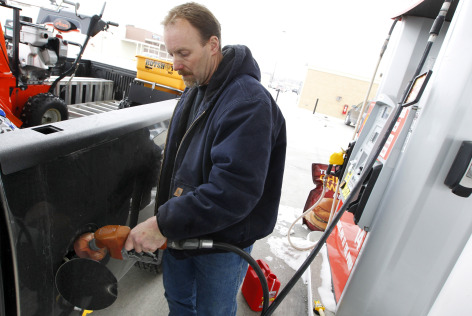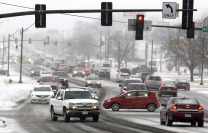
An increase in the state gas tax may not cost Iowans as much at the pump as they think, according to an ISU economic report. Photo by Christopher Gannon (Larger image)
AMES, Iowa – No one wants to pay more at the pump, but a possible increase in the state gas tax may not cost as much as some Iowans think. Dave Swenson, an associate scientist in economics at Iowa State University, calculated the average cost of a 10-cent increase, based on miles traveled and gas mileage.
For example, if you drive 20,000 miles a year and average 25 miles a gallon, you would pay an additional $80 a year, or about $7 a month. On the high end, someone driving 30,000 miles, averaging 10 miles a gallon would shell out an extra $300 a year. That’s compared to $25 more for someone driving 10,000 miles a year at 40 miles a gallon.
Swenson, who provides an annual calculation prior to the start of the legislative session, says this could be the year that Iowa lawmakers take action on the gas tax. He points to the unexpected drop in fuel prices and the fact that Gov. Terry Branstad has indicated he is open to discussing an increase. It’s a move Swenson said is long overdue.
“The gas tax has not been adjusted for a very long time and the consequences of that have been pretty harsh for the state’s road infrastructure,” Swenson said. “An increase is overdue, and there is broad-base support among a wide range of interests in the state of Iowa.”
According to the Iowa Legislative Services Agency, the gas tax was last increased in 1989. The current tax rate for regular gasoline is 21 cents a gallon, 19 cents for ethanol and 22.5 cents for diesel. Revenue from the tax supports the Road Use Tax Fund, which allocates money for state, county, city and rural road maintenance and repair. The Legislative Services Agency estimates that a 10-cent increase will generate $1.6 billion over nine years for the Road Use Tax Fund.
Tax vs. repairs and paying fair share
Motor vehicle transportation declined during the 2008 recession, falling well below projections for fuel tax revenues, Swenson said. Instead of rebounding as some experts expected, transportation rates have remained flat. As a result, the backlog of road repairs has grown at the state and national level, and the gap is widening every year, raising safety concerns about aging roads and bridges.

Swenson says motorists need to consider those safety issues and the potential damage to their vehicles. While people may not want to pay more in taxes, they are likely already paying more in car repairs.
“I caution people to think about the wear and tear on their car, suspension, shock absorbers, all the other parts that get rattled about and broken, and the things that happen to vehicles because of potholes,” Swenson said. “We are doing more damage to our vehicles on an annual basis than the cost of the increase in taxes.”
In addition to a tax increase, lawmakers may need to consider other ways to make sure all motorists are paying their fair share, Swenson said. Iowans with hybrid and electric cars avoid paying the tax or pay less than other motorists driving just as many miles.
“It’s kind of like taxes for online shopping. We know there’s something wrong there, but we don’t quite know how to deal with it,” Swenson said.
One option would be to restructure license fees based on the size and value of the vehicle as well as miles traveled, Swenson said. However, reporting miles traveled could create an incentive to cheat, he added. Similar programs are being tested in Colorado, Minnesota, Nevada, Oregon, Texas and Washington, according to the Legislative Services Agency.
